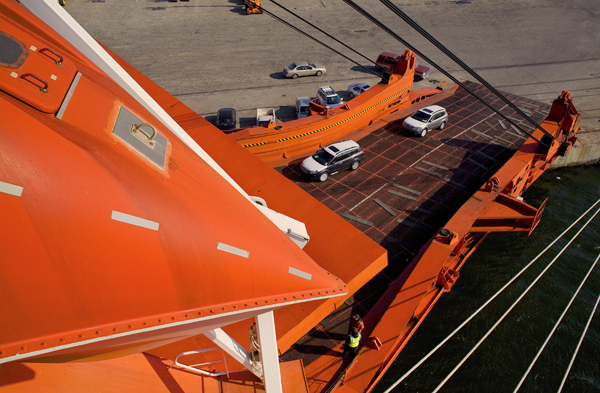 Complex, multimodal, multi-activity supply chains call for smart management systems. For WWL, that has meant a decade-long partnership with UK software specialist ProAct International
Complex, multimodal, multi-activity supply chains call for smart management systems. For WWL, that has meant a decade-long partnership with UK software specialist ProAct International
Wallenius Wilhelmsen Logistics (WWL) is one of the world’s largest specialist ro-ro carriers, however the company’s infrastructure and activities go far beyond its 60-strong vessel fleet. Today, the company’s operations include the management of 13 terminals and 58 processing facilities worldwide, which form a focal point for inland distribution and a broad range of technical service activities. Over time, WWL’s land-based services have in some ways become at least as important as its marine activities. “In fact, while we ship 2m units by ocean every year, we touch nearly 6m units on land,” says Torbjörn Dimblad, vice-president of supply chain solutions and network development.
![]() As WWL’s range of services has become more comprehensive, so managing them as efficiently as possible has become more challenging. The company uses a number of different software packages, many developed in-house, to manage different parts of its offerings. The search for a new ‘overarching’ solution started around a decade ago, recalls Dimblad, when WWL was asked by a major carmaker to propose a complete finished vehicle supply chain from factories in Europe, the US and
As WWL’s range of services has become more comprehensive, so managing them as efficiently as possible has become more challenging. The company uses a number of different software packages, many developed in-house, to manage different parts of its offerings. The search for a new ‘overarching’ solution started around a decade ago, recalls Dimblad, when WWL was asked by a major carmaker to propose a complete finished vehicle supply chain from factories in Europe, the US and
Click on the links below to read the different articles that make up this report.
South Africa to dealers across Australia and New Zealand. Recognising that it needed further IT capabilities than it had at the time to manage such a network, the company began to search the market.
“There were not a lot of intermodal outbound solutions in existence at that time,” he says. “We ended up selecting ProAct as our IT supplier for that bid, which we won, and we are still using the system for that and similar supply chains ten years later.”
ProAct describes its Enterprise Supply Chain Manager (ESM) as an “integrated end-to-end multimodal supply chain planning and execution solution” designed for dynamic and collaborative supply chains. WWL uses the ProAct system as a way of orchestrating the many other in-house, customer and supplier systems involved. The systems holds a record of all the activities that must happen on a particular vehicle in the supply chain, allocates those activities to appropriate resources and tracks their execution.
Managing by exceptions
“The ProAct system can take information about transportation schedules across various modes and combine it with the activities to be performed to provide a full itinerary for a unit to its final destination,” says Dimblad, “That is a pretty unique proposition. Usually, customers know where their units are now and they have good visibility of their history, but a clear picture of the remaining steps is a
difficult ask.”
Critically, the ProAct system allows WWL to add rules to automate decision making in the event of unexpected changes. “For example, we can use smart routing logic to book a vehicle onto the next ship if a delay means it doesn’t meet its original schedule,” he explains. “When issues occur, we can decide whether to take those sorts of decisions automatically, or to alert operators to the problem and ask them for confirmation.”
The power of that automation, says Dimblad, “is that it lets you get to exception-based management of complex supply chains and that, in turn, means you can scale volumes without needing to scale the number of logistics coordinators you need at the same rate.”
As an example of what can be achieved when humans only have to intervene to manage the exceptions a system can’t, Dimblad cites the example of another software package, developed in-house by WWL, which allows five or six people to manage over 1m invoices a year for one customer.
In practice, however, a high degree of automation across complex supply chains usually takes time to achieve. “When you discuss a new project, everyone tends to be optimistic,” says Dimblad. “There are always learnings during the implementation and many more during operations.

While it takes time and experience to perfect the models used to manage particular supply chain flows, WWL’s experience with ProAct also helps it to create simple models quickly, something the organisation finds helpful when bidding for and setting up new contracts. “We have tried to anticipate the future and make generic solutions that we can reuse wherever possible, “ says Dimblad, “So now, we can sit down with a customer to discuss their requirements and a few days later we can come back to them with a model, and say ‘this what it could look like’.”
A two-way exchange
Dimblad is keen to point out that the relationship with ProAct has been two-way, with the software provider continually making refinements and additions to its software in response to its customer’s needs. “For example, to transport larger high-and-heavy cargo, it is common to dismantle a unit, transport the components separately and reassemble them at the final destination,” he explains. “ProAct created the functionality in the system to allow us to handle that type of activity.”
More recent system additions have focused on further improving logistics coordinator productivity, with an automated ‘to-do list’ system that collects and prioritises actions requiring attention from operators.
 "The amount, and visibility, of data we have in the supply chain is increasing all the time... The sweet spot in the next five years will come from the ability to make operational decisions based on that data"
"The amount, and visibility, of data we have in the supply chain is increasing all the time... The sweet spot in the next five years will come from the ability to make operational decisions based on that data"- Torbjörn Dimblad, WWL
For ProAct, says company chairman Garth Parker, the experience of working with WWL has been “a very maturing relationship”. “The scale of what WWL does is amazing and having a customer like that has really helped us to move on and ensure our product stays relevant to the needs of the industry,” he explains.
ProAct’s close relationship with each of its major customers, both within and outside the automotive industry, provides benefits to all of them, Parker adds. He notes that the order management system currently used by WWL was originally developed for ProAct’s customers in the online retail industry.
So where are the remaining opportunities to improve supply chain performance with smart software? Torbjörn Dimblad suggests that the next frontier will be the use of advanced analytics. “The amount, and visibility, of data we have in the supply chain is increasing all the time, from sources like GPS devices,” he says. “The sweet spot in the next five years will come from the ability to make operational decisions based on that data.”
Quite how soon that happens will depend on WWL’s customers as much as its technical capabilities, however. “Manufacturers are already leveraging operations research and predictive analytics, especially on the inbound logistics side,” he says. “It may be some time before this matures fully in outbound logistics at the operational level, but I don’t doubt that it is coming.”


























![Global[1]](https://d3n5uof8vony13.cloudfront.net/Pictures/web/a/d/s/global1_726550.svgz)









